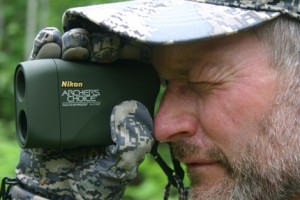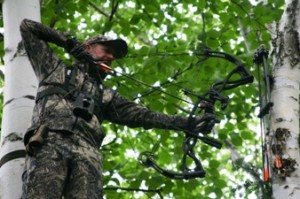Tips and Tactics for Filling Your Deer Tags
Long Before the Rut
![]() By Bob Robb for The Havalon Post
By Bob Robb for The Havalon Post
It was hot. Real hot, dang hot, the kind of heat that makes a man sweat like he’s in an oven even while sitting in the shade. Still, I liked my chances. I’d found a small, secluded water hole on the edge of thick woods situated about a quarter mile from a big green field. There were deer tracks all over the edge, so I set a stand on the downwind side of the pond where I’d be buried in afternoon shade and gave it a go. 
It took three evenings before a dandy 8-point stopped by for a drink with just enough light left to see my sight pins. He’d been bedding nearby and was on his way to have supper in the field. Instead, he got to ride in the back of my truck.
This global warming thing may or may not be the real deal, but what I do know is where I hunt whitetails during the early seasons, it sure has been hot lately. Real hot. The kind of hot that makes everything that walks or crawls go underground during the heat of the day.
“They’re butterball fat and prime for the table now,
so why wait until the rut…”
Those of us who enjoy bowhunting early season deer have to deal with the heat. We fight off the biting insects and buzzing flies, make sure our stands are in a shady spot that catches whatever breeze may be blowing, and stay well hydrated. In this we are a lot like deer. And knowing that deer are just as uncomfortable as you are when the weather is hot is a big step on the road to getting a shot at one in T-shirt & shorts weather.
After three decades of whitetail hunting from August to New Year’s day, I have come to believe there are a few rules that, when followed, will at least give you a fighting chance to kill a deer when the mercury soars. These include hunting field edges, hunting only in the afternoon, and hunting over water.
Hunt in the Afternoon
I only hunt afternoons early on for one simple reason. In really hot weather the chances of catching a mature buck out of his bed when the rooster crows are so small they are not worth either the time or the chance that you will spook deer walking to your stand in the dark. Most all deer are bedded down when the sun kisses the sky, resting and ruminating after a long night of foraging. Mornings are reserved for following my usual routine at home or work, or if I have a little time I may do some scouting.
Hunt Field Edges
In the afternoons, there are two killer stand locations to concentrate on. The first and most commonly hunted is at or near the edge of a crop field. Deer generally leave their beds late in the afternoon and head for supper in the nearest food plot or cultivated field, arriving shortly before sundown. You can almost bet the farm that the first deer to arrive will be does and yearlings followed by 1 ½-year old bucks. If mature bucks are going to show themselves they generally do so as it is pushing the legal shooting hours limit.
For that reason picking exactly the right stand site is critical. You won’t have a lot of time once a mature buck appears, so you need to have him appear as close to shooting range as possible. This is where your scouting comes into play.  I like using infrared trail cameras set on trails leading to the field to capture images of deer back off the field as I try to figure out which trails they like. Rather than willy-nilly setting the camera on a tree and hoping it is the right one, I will clear spots on several good-looking trails and then look for big tracks that indicate mature deer are using it.
I like using infrared trail cameras set on trails leading to the field to capture images of deer back off the field as I try to figure out which trails they like. Rather than willy-nilly setting the camera on a tree and hoping it is the right one, I will clear spots on several good-looking trails and then look for big tracks that indicate mature deer are using it.
Hunt Over Water
The other great stand spot in hot weather is around a water source. This can be everything from a small creek or pond to a stock tank or large lake. Many times in the afternoon deer will get up from their beds and stretch a little before slowly browsing their way to the agriculture. Often they stop at a water source for a quick drink.
When deciding whether or not to sit over water, first you have to make sure deer are using it. Look for fresh tracks – old, dried up tracks mean nothing. Again, scouting cameras set up on trails leading to and from the water source can tell you what type of deer are drinking here, and just as importantly, at what time they like to come by. One thing I sometimes do is set a couple of cameras around a water hole to see what’s what.
The most important information I can get from the cameras is not the size of the bucks using the trail, but the time of day the deer are drinking. If 99 percent of the activity is after legal shooting hours, why bother? But if there is good deer movement past the water during shooting light, I’ll spend some time hunting there.
“I also set tree stands relatively high this time of year to help dissipate my scent stream…”
Regardless of which spot I choose to hunt, there are some constants about stand site selection. Naturally the wind direction is critical. Just as important to me is shade.  Not only will you shine like a beacon if you are sitting in a treestand lit by the sun, you’ll be miserable as well.
Not only will you shine like a beacon if you are sitting in a treestand lit by the sun, you’ll be miserable as well.
Get tucked into some leafy shade where the breeze can cool you and you’re good to go. I also set tree stands relatively high this time of year to help dissipate my scent stream, as well as use gallons of a quality scent-eliminating spray.
Ground blinds can be a good ambush option as well, especially if the deer are accessing a field or large body of water at a spot where no good tree-stand trees are available. The downside to the blind is that it will get really warm inside, so be sure you bring lots of liquids. An inexpensive battery-powered fan can also help you keep cool.
You’ll also have to deal with irritating insects. Bug dope is great but it smells. That’s why a ThermaCell can be the ticket. They’re relatively odorless, easy to use, can clip onto your clothing or stand, and work great.
The other thing you must be aware of hunting during the hot temperatures of the early season is meat care. It is imperative you field dress the animal as soon as possible, taking great care to not inadvertently slice into the digestive tract or bladder and spill urine or digestive juices onto the meat. Doing so is the best way there is to ruin all that great-eating venison.
That all begins with the right knife. I’ve become especially enamored with Havalon’s “Quik-Change” Piranta skinning knives and new Baracuta fillet knives. They’re light weight with surgically-sharp blades – the same blades taxidermists have been buying from the company for more than two decades. With quick-change blades, you never have to use a dull knife again, instead being able to quickly and easily change to a new blade in the middle of the job. Once I have the animal back to the house, I quickly peel the hide off, wash the meat down to remove all blood, quarter it, then get the quarters on ice.
There’s no doubt that early-season hunting is not generally as productive as hunting in cooler weather, when the mast crop begins falling and the rut kicks in. The early season can be a way to locate stand sites for the rut, and will give you a good feel for what is going on in the woods you’ll be focusing on later in the year. It is also the best time of year to harvest any antlerless deer you may want to take off the property. They’re butterball fat and prime for the table now, so why wait until the rut, when you can use does as live bait for mature bucks and shooting does can muck up a great rut stand?
One other note. Hunt with as little impact as possible during the early season. The last thing you want to do is let the older age-class bucks know that something is amiss. I never hunt my best rut stands during the early season for this very reason. Be a stealth bomber, though, and you can have lots of fun and, if things shake out like they sometimes do, the results just might surprise you.
About Bob Robb
Bob has had articles and photographs appear in most major outdoor magazines for over two decades. A former editor of Fishing & Hunting News, Western Outdoor News, and Petersen’s Fishing, Bob was founding editor of Petersen’s Bowhunting magazine. He is the author of many books, including The Field & Stream Bowhunting Handbook, and The Ultimate Guide to Elk Hunting. We’re honored to know that Bob likes our knives.
Do you have any tips for early season deer hunting?
14,418 total views, no views today


 Now that we’re into the various hunting seasons (at last!), I know a lot of people will be skinning and deboning a deer, elk or other large animal with one of our knives for the first time. Havalon knives are different from traditional skinning knives. You may need to learn a slightly different style of cutting to get the most out of your Havalon.
Now that we’re into the various hunting seasons (at last!), I know a lot of people will be skinning and deboning a deer, elk or other large animal with one of our knives for the first time. Havalon knives are different from traditional skinning knives. You may need to learn a slightly different style of cutting to get the most out of your Havalon.
![PirantaWhitetail_Angled_fishbkgrd_lrzcrop[1] PirantaWhitetail_Angled_fishbkgrd_lrzcrop[1]](http://blog.havalon.com/wp-content/uploads/2010/08/PirantaWhitetail_Angled_fishbkgrd_lrzcrop1-300x285.jpg)
![PirantaWhitetail_HandleCloseUp_lrz[1] PirantaWhitetail_HandleCloseUp_lrz[1]](http://blog.havalon.com/wp-content/uploads/2010/08/PirantaWhitetail_HandleCloseUp_lrz11-300x63.jpg)